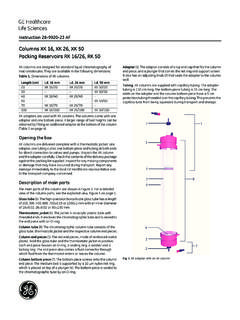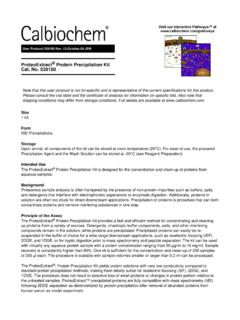Transcription of Reversed Phase Chromatography - Wolfson Centre …
1 Reversed PhaseChromatographyPrinciples and Methods18-1134-16 Edition AAReversed PhaseChromatographyContents1. Introduction .. 5 Theory of Reversed Phase Chromatography .. 6 The matrix .. 9 The ligands .. 11 Resolution in Reversed Phase Chromatography .. 13 Resolution .. 13 Capacity factor .. 14 Efficiency .. 15 Selectivity .. 17 Binding capacity .. 18 Critical parameters in Reversed Phase Chromatography .. 19 Column length .. 19 Flow rate .. 19 Temperature .. 20 Mobile Phase .. 20 Organic solvent .. 20 Ion suppression .. 21 Ion pairing agents .. 22 Gradient elution .. 23 Mode of use .. 24 Desalting .. 24 High resolution separations .. 25 Large scale preparative purification .. 25 Stages in a purification scheme .. 26 Capture .. 26 Intermediate stages .. 27 Polishing .. 272. Product Guide .. 29 SOURCE 30 Product description .. 30 High chemical stability .. 32 Excellent flow/pressure characteristics .. 34 High capacity .. 35 Availability .. 36 RPC C2/C18 .. 37 Product description.
2 37 Chemical and physical stability .. 38 Flow/pressure characteristics .. 38 Capacity .. 38 Availability .. 39 Sephasil Protein/Sephasil Peptide .. 39 Product description .. 39 Chemical and physical stability .. 40 Flow/pressure characteristics .. 40 Availability .. 403. Methods .. 41 Choice of separation medium .. 41 Unique requirements of the application .. 41 Resolution .. 41 Scale of the purification .. 42 Mobile Phase conditions .. 42 Throughput and scaleability .. 42 Molecular weight of the sample components .. 42 Hydrophobicity of the sample components .. 43 Class of sample components .. 43 Choice of mobile Phase .. 44 The organic solvent .. 44pH .. 46 Ion pairing agents .. 47 Sample preparation .. 49 Mobile Phase preparation .. 50 Storage of mobile Phase .. 50 Solvent disposal .. 50 Detection .. 51 Ghosting .. 51 Mobile Phase balancing .. 51 Column conditioning .. 52 Elution conditions .. 53 Column re-equilibration .. 55 Column cleaning .. 55 Column storage.
3 564. Applications .. 57 Designing a biochemical purification .. 57 Naturally occurring peptides and proteins .. 58 Purification of platelet-derived growth factor (PDGF) .. 59 Trace enrichment .. 59 Purification of cholecystokinin-58 (CCK-58) from pig intestine .. 60 Recombinant peptides and proteins .. 62 Process purification of inclusion bodies .. 63 Purification of recombinant human epidermal growth factor .. 63 Chemically synthesised peptides .. 65 Purification of a phosphorylated PDGF -receptor derived peptide .. 65 Structural characterisation of a 165 kDa protein .. 66 Protein fragments from enzyme digests .. 66 Protein characterisation at the micro-scale .. 66 Protein identification by LC-MS .. 69 Chemically synthesised oligonucleotides .. 705. Fault finding chart .. 726. References .. 817. Ordering information .. 845 Chapter 1 IntroductionAdsorption Chromatography depends on the chemical interactions between solutemolecules and specifically designed ligands chemically grafted to achromatography matrix.
4 Over the years, many different types of ligands havebeen immobilised to Chromatography supports for biomolecule purification,exploiting a variety of biochemical properties ranging from electronic charge tobiological affinity. An important addition to the range of adsorption techniques forpreparative Chromatography of biomolecules has been Reversed phasechromatography in which the binding of mobile Phase solute to an immobilisedn-alkyl hydrocarbon or aromatic ligand occurs via hydrophobic Phase Chromatography has found both analytical and preparativeapplications in the area of biochemical separation and purification. Moleculesthat possess some degree of hydrophobic character, such as proteins, peptides andnucleic acids, can be separated by Reversed Phase Chromatography with excellentrecovery and resolution. In addition, the use of ion pairing modifiers in themobile Phase allows Reversed Phase Chromatography of charged solutes such asfully deprotected oligonucleotides and hydrophilic peptides.
5 Preparative reversedphase Chromatography has found applications ranging from micropurification ofprotein fragments for sequencing (1) to process scale purification of recombinantprotein products (2).This handbook is intended to serve as an introduction to the principles andapplications of Reversed Phase Chromatography of biomolecules and as a practicalguide to the Reversed Phase chromatographic media available from AmershamBiosciences. Among the topics included are an introductory chapter onthe mechanism of Reversed Phase Chromatography followed by chapters onproduct descriptions, applications, media handling techniques and orderinginformation. The scope of the information contained in this handbook will belimited to preparative Reversed Phase Chromatography dealing specifically withthe purification of proteins, peptides and nucleic of Reversed Phase chromatographyThe separation mechanism in Reversed Phase Chromatography depends on thehydrophobic binding interaction between the solute molecule in the mobile phaseand the immobilised hydrophobic ligand, the stationary Phase .
6 The actualnature of the hydrophobic binding interaction itself is a matter of heated debate (3)but the conventional wisdom assumes the binding interaction to be the result of afavourable entropy effect. The initial mobile Phase binding conditions used inreversed Phase Chromatography are primarily aqueous which indicates a highdegree of organised water structure surrounding both the solute molecule and theimmobilised ligand. As solute binds to the immobilised hydrophobic ligand, thehydrophobic area exposed to the solvent is minimised. Therefore, the degree oforganised water structure is diminished with a corresponding favourable increasein system entropy. In this way, it is advantageous from an energy point of viewfor the hydrophobic moieties, solute and ligand, to associate (4).Fig. 1. Interaction of a solute with a typical Reversed Phase medium. Water adjacent tohydrophobic regions is postulated to be more highly ordered than the bulk water.
7 Part of this structured water is displaced when the hydrophobic regions interact leading to an increase in theoverall entropy of the Phase Chromatography is an adsorptive process by experimental design,which relies on a partitioning mechanism to effect separation. The solutemolecules partition ( an equilibrium is established) between the mobile phaseand the stationary Phase . The distribution of the solute between the two phasesdepends on the binding properties of the medium, the hydrophobicity of thesolute and the composition of the mobile Phase . Initially, experimental conditionsare designed to favour adsorption of the solute from the mobile Phase to thestationary Phase . Subsequently, the mobile Phase composition is modified tofavour desorption of the solute from the stationary Phase back into the mobilephase. In this case, adsorption is considered the extreme equilibrium state wherethe distribution of solute molecules is essentially 100% in the stationary , desorption is an extreme equilibrium state where the solute isessentially 100% distributed in the mobile +abcMatrixStructured water7 Fig.
8 2. Principle of Reversed Phase Chromatography with gradient Phase Chromatography of biomolecules generally uses gradient elutioninstead of isocratic elution. While biomolecules strongly adsorb to the surface ofa Reversed Phase matrix under aqueous conditions, they desorb from the matrixwithin a very narrow window of organic modifier concentration. Along withthese high molecular weight biomolecules with their unique adsorptionproperties, the typical biological sample usually contains a broad mixture ofbiomolecules with a correspondingly diverse range of adsorption affinities. Theonly practical method for Reversed Phase separation of complex biologicalsamples, therefore, is gradient elution (5).In summary, separations in Reversed Phase Chromatography depend on thereversible adsorption/desorption of solute molecules with varying degrees ofhydrophobicity to a hydrophobic stationary Phase . The majority of reversedphase separation experiments are performed in several fundamental steps asillustrated in Figure first step in the chromatographic process is to equilibrate the column packedwith the Reversed Phase medium under suitable initial mobile Phase conditions ofpH, ionic strength and polarity (mobile Phase hydrophobicity).
9 The polarity ofthe mobile Phase is controlled by adding organic modifiers such as agents, such as trifluoroacetic acid, may also be appropriate. Thepolarity of the initial mobile Phase (usually referred to as mobile Phase A) mustbe low enough to dissolve the partially hydrophobic solute yet high enough toensure binding of the solute to the Reversed Phase chromatographic the second step, the sample containing the solutes to be separated is , the sample is dissolved in the same mobile Phase used to equilibrate thechromatographic bed. The sample is applied to the column at a flow rate whereoptimum binding will occur. Once the sample is applied, the chromatographicbed is washed further with mobile Phase A in order to remove any unbound andunwanted solute samplesubstances3 Start ofdesorption4 End ofdesorption5 Regeneration8 Bound solutes are next desorbed from the Reversed Phase medium by adjusting thepolarity of the mobile Phase so that the bound solute molecules will sequentiallydesorb and elute from the column.
10 In Reversed Phase Chromatography this usuallyinvolves decreasing the polarity of the mobile Phase by increasing the percentageof organic modifier in the mobile Phase . This is accomplished by maintaining ahigh concentration of organic modifier in the final mobile Phase (mobile Phase B).Generally, the pH of the initial and final mobile Phase solutions remains the gradual decrease in mobile Phase polarity (increasing mobile phasehydrophobicity) is achieved by an increasing linear gradient from 100% initialmobile Phase A containing little or no organic modifier to 100% (or less) mobilephase B containing a higher concentration of organic modifier. The bound solutesdesorb from the Reversed Phase medium according to their fourth step in the process involves removing substances not previouslydesorbed. This is generally accomplished by changing mobile Phase B to near100% organic modifier in order to ensure complete removal of all boundsubstances prior to re-using the fifth step is re-equilibration of the chromatographic medium from 100%mobile Phase B back to the initial mobile Phase in Reversed Phase Chromatography is due to the different bindingproperties of the solutes present in the sample as a result of the differences in theirhydrophobic properties.









